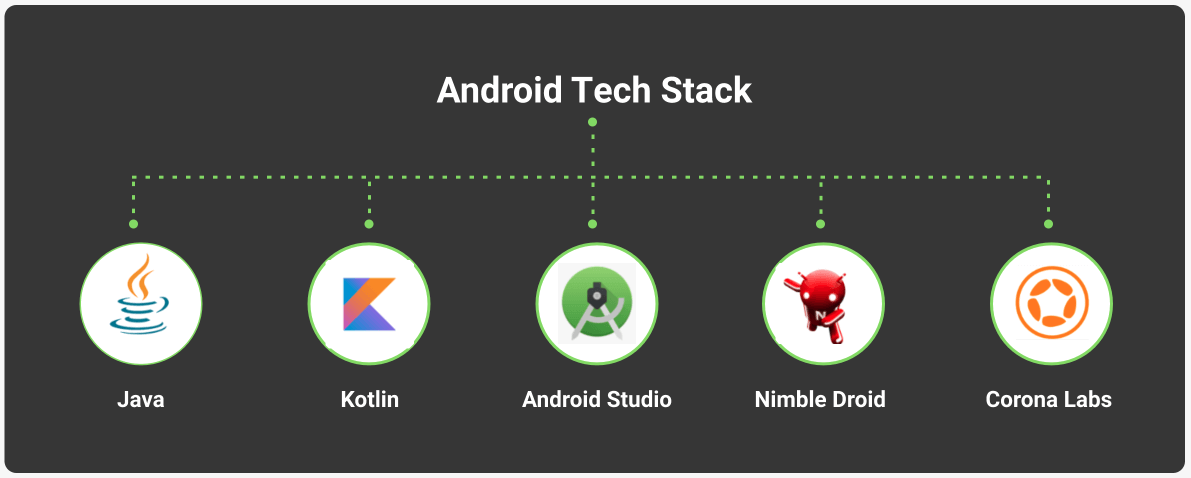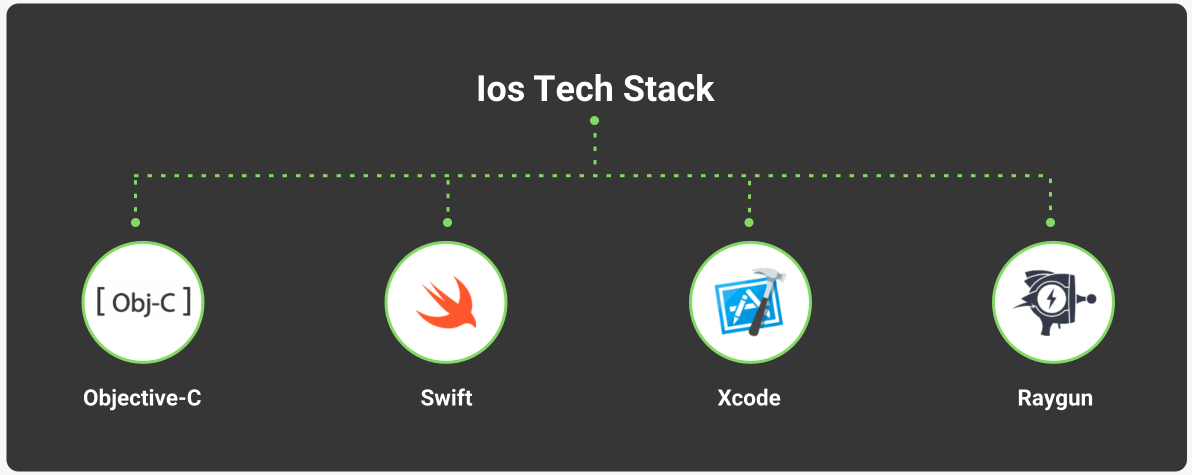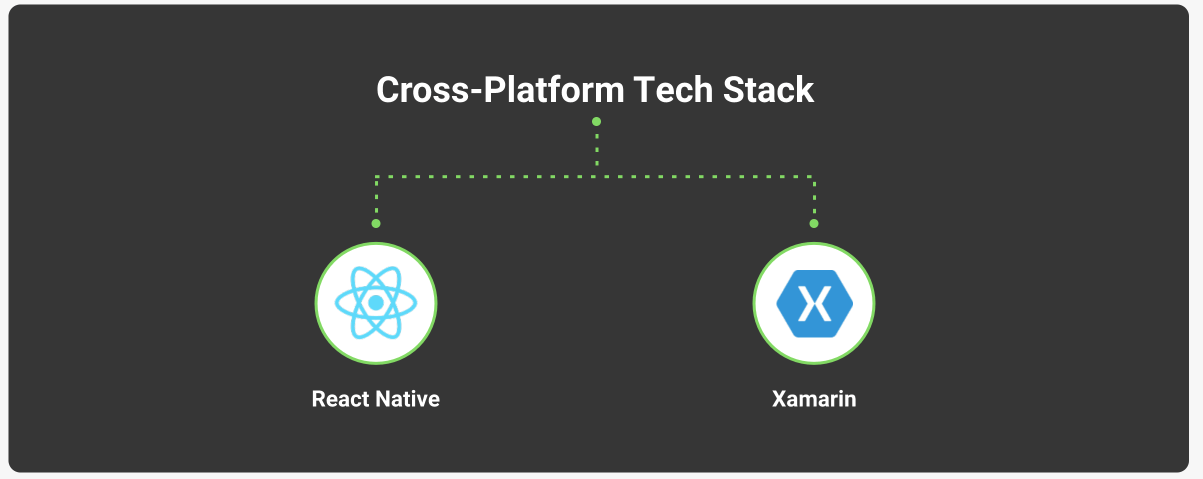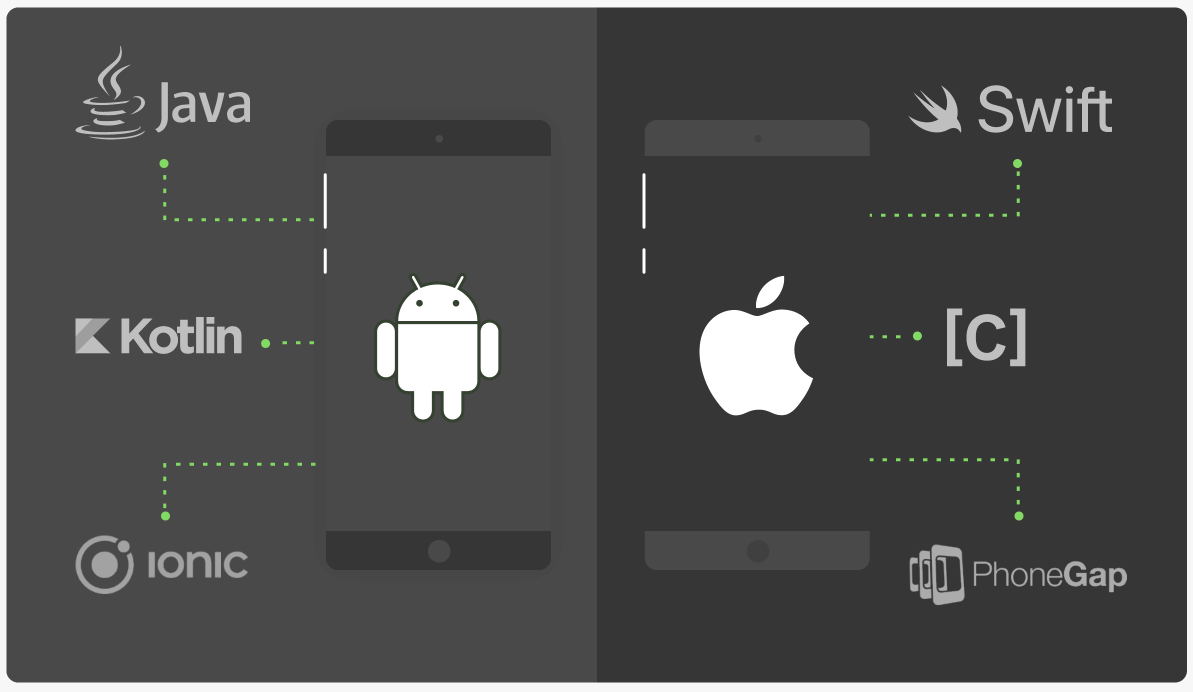After your idea is validated and you have developed a strategy for your project creation, it’s time to find your best tech stack for a mobile app. This is one of the most critical steps in your project development since the right choice of technologies dramatically contributes to your project’s overall success. So, let’s find out how to make the right decision out of the many alternatives around.
What Is a Tech Stack and Why You Can’t Go Wrong With Its Choice
A tech stack is a set of tools you use or intend to use for your mobile application development. They can be divided into the front-end and back-end tools, plus some experts suggest adding testing and debugging tools to the list. In any case, the choice of your mobile application technology stack is quite important, and here is why.
According to research, “When starting a project with the purpose of software development, it is very important to use a methodology that increases its success rate. A report of the Standish Group International on projects success rates shows that 32% of all projects succeeded (delivered on time, on budget, with required features and functions), 44% were challenged (late, over budget, and/or with less than the required features and functions) and 24% failed (canceled prior to completion or delivered and never used). The use of an adequate methodology plays an important role in developing software, to assure that it is delivered within schedule, within the cost, and meets users’ requirements.”
So, taking into account the statement above, the ideal technology stack for mobile apps should match the following criteria.
Your Technologies Stack Should Be Safe to Use
Security is one of the most crucial issues when choosing which technologies to use. Nowadays, with cybercrime on the rise, the safety of your future solution and its data protection capabilities should come first.
It Should Fit Into the Project Requirements
Depending on the project's size, the choice of technologies will differ since each of them has specific opportunities for withstanding high loads and scaling. Indeed, the project size is not the only factor to take into account. There can be a lot of other specific details, for example, the necessity for instant data transfer (for live video streaming apps), tons of animated elements (for mobile games and entertainment apps), in-app data analysis features (for ML-powered apps), and many other factors. Thus, each detail and requirement matters when making a final decision on the tech stack.
It Should Contribute to Your Project Success
When choosing your tech stack for mobile app development, you should assess the benefits it may provide for your project. For example, consider the ease of mastering the technology and the development speed it may provide.
So, let’s find out the possible tech stacks for mobile applications depending on the operating system and the development approach.
Native App Development
Native development is a collective term that includes the creation of applications for specific operating systems. This means that the set of technologies and tools will be relatively wide and directly dependent on the operating system you want to use to create your application.
According to research, “Native applications for smartphones and tablets include software written in Java for Android, Objective C for iPhone, C++ for Symbian, and C++ for Windows Mobile. Programs written for the device’s native runtime environment have rich APIs and tend to be able to use all the facilities of the phone, including sensors, media playback, file management, and network access.”
The following are the possible technology stacks for mobile app development for Android, iOs, and Windows. They contain application programming languages and additional mobile development tools that facilitate and streamline the application building process.
Tech Stack for Android Apps

Android is the most used operating system globally, so there are many tools you may choose from if you want to come up with stunning Android applications. ✔Programming languages: Java, Kotlin
✔App development tools: Android Studio, Nimble Droid, Corona Labs
Java. This is the primary language for Android development and one of the most used and popular programming languages in the world. As for its benefits, this is one of the easiest languages to learn (maybe only Python is easier). It has strong security potential. It is an object-oriented language that allows for creating modular programs, and it comes with an expansive talent pool of Java developers to choose from.
Kotlin. Kotlin is somewhat specific; however, this is the real-life savior when it comes to developing two native solutions. In this case, Kotlin is a great chance to significantly cut costs since a lot of elements created with
Kotlin for Android apps may be easily reused for an iOS native solution.Android Studio. This is the whole set of Android-specific technologies that allows you to streamline the creation of your solution. There are many ready-made code templates, the opportunity to emulate your future app’s usage, and make better decisions at this stage, plus there is Kotlin support.
Nimble Droid. This is the top tool for Android application testing. It includes automated crash detection, application performance analytics, user flow analysis, and visual reporting.
Corona Labs. If you are going to create a 2D game for Android or any other app with many animated elements, there is a need for Corona Labs. With this tool, you may choose from 1000+ APIs for the gaming experience, use a real-time stimulating feature, and enjoy live testing opportunities.
Tech Stack for iOS Apps

iOS development is quite specific, and you should be very careful when choosing a tech stack for mobile applications created for Apple users. The fact is that the Apple Store has stringent requirements regarding the stuffing, design, and security features for published apps. So, you should come up with a technology set that will perfectly meet your project’s specifications and allows you to follow the App Store’s requirements.
✔Programming language: Objective-C, Swift
✔App development tools: xCode, Raygun
Objective-C. There are many arguments around the pros and cons of Objective-C, and some development experts insist on the necessity of Swift usage only. However, you should know that Objective-C is stable and secure. Sometimes it is the best choice for iOS app programming. It was quite popular several years ago, but now it is mostly used to support legacy projects, and new ones are created with Swift. Still, you may rely on this language when you need to use C or C++ frameworks since these technologies are fundamental ones.
Swift. Compared to Objective-C, Swift allows for creating faster and better performing applications. Also, using Swift, less code is needed, which will be ideally readable. It is an open-source language that is continuously developed and improved by Apple, and that is why this is the primary choice for iOS native development.
Xcode. This is an all-in-one solution that allows for creating applications for any Apple device. It provides the opportunity for easy coding, as filtering, prototyping, and testing are already built-in.
Raygun. This is a potent tool for iOS apps testing. With its help, you may find invisible errors in the code, test the app performance, get an automated report on crashes, and gain insights into real users’ behavior patterns and scenarios.
Tech Stack for Windows Apps

The Windows operating system is less popular compared to Android and iOS, but it still has the full right to exist. So, if you are going to create a mobile application for the Windows platform, here are the technologies to choose from.
✔Programming language: C++, C#
✔App development tools: Microsoft Visual Studio, Azure DevOps
C++. This is one of the oldest programming languages (created in 1988); however, there are still no doubts about its quality. The technology is object-oriented and multi-paradigm with good memory management opportunities and broad community support. However, there are some security issues, so you should find ways to overcome them in advance.
C#. This is a good choice for Windows mobile and desktop solutions and games created with Unity and console applications. This language can also be used in cross-platform development because of its versatility, compatibility, Integrity, and interoperability.
Microsoft Visual Studio. This is the whole set of tools that allows for easy code creation, team collaboration, debugging, and code diagnostics.
Azure DevOps. This is another useful environment for streamlining development and operational specialists using planning, visualization, and reporting tools inside, pipelines, repos, artifacts, and test plans.
Cross-platform App Development

Cross-platform development is a great choice when developing an app for two different platforms on a limited budget. For example, the share of Android and iOS users are almost equal among your target audience, but the cost is too high for two native custom mobile app development services. Here are the technology stacks for mobile applications created according to the cross-platform approach.
✔App development tools: React Native, Xamarin
React Native. This is a technology that doesn’t need to be introduced since it is very popular and effective. Developed by Facebook, this framework is a real-time-to-market booster. The pieces of code created can be easily reused, and there is a great chance to reach the close-to-native experience.
Xamarin. This is a great solution that allows you to create a cross-platform application and use it at some stages of developing the native app. The tool is free and open-sourced but still provides for creating awesome cross-platform interfaces and designs. With the help of Xamarin Forms, you may develop apps for Android, iOs, and Windows according to the Model-View-ViewModel design pattern.
Thinking about whether cross-platform development is right for your project? Let's figure it out together. What’s more, we know the best-cross platform app creation practices and are ready to share them with you.
Start Our ConsultationHybrid App Development

A hybrid mobile application is a kind of attempt to combine the native and cross-platform approach. However, there are still some limitations in user experience and usability compared to native solutions. On the one hand, hybrid applications are installed on devices by default. On the other hand, special technologies are used to create them. Here they are.
✔App development tools: Ionic, PhoneGap
Ionic. Driven by the motto “Write once, run anywhere,” Ionic becomes a powerful tool for hybrid development while being easily combined with native frameworks like Angular, Vue.js, or React. All the features come for free.
PhoneGap. PhoneGap is teeming with awesome user interfaces to improve the experience of interacting with your hybrid app even more. There are many useful APIs and a lot of tools compatible with Android, iOS, Blackberry, and other operating systems.
Feel like hybrid application development is the right strategy for your solution? Perhaps, this is so; however, let’s do everything right from the very beginning. Our extensive experience in creating hybrid apps will be of great use to you.
Get in Touch With UsSome of the Ready-Made Web Technologies Stacks
Above, we have considered the leading technologies for mobile application development. However, mobile applications are rarely created without accompanying web versions and branded websites of the app creators. Therefore, let's take a quick look at the already created technology stacks that make your choices easier for web development.
MEAN. This solution stack stands for MongoDB, Express.js, Angular.js, and Node.js technologies. It is a perfect toolset for dynamic web development. The coders may use JavaScrip only to create client and server-side parts of the app, which significantly speeds up the whole development process.
LAMP. As for LAMP, which combines Linux, Apache, MySQL, PHP/Perl/Python, this tech set is one of the oldest technology stacks on the IT market. However, it is still used when there is no need to reinvent the wheel.
MERN is the most popular stack after MEAN. This tech set includes MongoDB, Express, React, and Node and is the perfect choice when customization opportunities, flexibility, and development speed are equally important.
MEVN stack incorporates MongoDB, Express.js, VueJS, and Node.js. and is sometimes considered slightly outdated. However, these technologies are still suitable for creating robust dynamic web solutions with the intent of further scaling.
How to Choose the Best Tech Stack for Mobile App?

Now that we have figured out the technologies and their stacks and described the tools specific to different operating systems and approaches to application development, it's time to make the final choice. Do it considering the following factors.
Time to market
Time to market becomes a critical factor when you plan to launch your product in a highly competitive environment. In this case, look at the technology's ease of use and its ability to create reusable parts of the application. For example, Kotlin for Android development meets both parameters, and Swift is a perfect and speedy solution for iOS development.
Talent pool
Also, pay attention to the labor market. You will have no difficulty assembling your team for popular technologies like Java since there are 10,000,000 Java coders on the planet. Other popular technologies will also not leave you without a choice of talents, especially if you decide to outsource your development (for example, to Ukraine) and not limit yourself to your location.
However, if your project needs a specific technology, requiring a specific specialist, their search and testing can take time. In this case, it makes sense to consider partial outsourcing.
Speed
Some technologies were created to speed up the development process without losing quality. However, a strategic approach is also needed here. Sometimes a difficult-to-learn technology is the only way out, and then it is better to invest time right away than to redo the project from scratch.
The opportunity to reuse/optimize
This factor becomes especially important when you need to create two native applications, plus a website, plus you still have spare ideas that you want to implement in the future but do not want to invest too much at the start. In this case, you need to think about everything in advance. For example, the aforementioned Kotlin and Swift are good for optimizing the development process since the same module can be reused either in its original form or with minimal changes.
Cost
As you already understood from our review, some tools are available completely free of charge, while others open up access to the best features at a fairly substantial cost. Therefore, you need to take into account the bandwidth of your budget.
Prompt! In most cases, free tools are sufficient unless you have plans to program a spaceship.
Scaling opportunities
Business strategy is also essential for making the right choice of technology. What fate do you foresee for your solution? Chances are, you see it as a popular application that is increasing the number of users day after day. To not spoil the user experience, you immediately need to choose a technology that does not block the possibility of scaling. Moreover, there are additional machine learning-based tools to help you automatically scale your solution in the future.
Trends
Trends are also important for both mobile and web development. This means that you will have to choose those technologies that will allow you to stay on the same page with your users. For example, development trends in 2021 include artificial intelligence, virtual and augmented reality, and the Internet of Things. Therefore, you will have to make choices within these areas.
Conclusion
Choosing the right technologies stack for your future project is challenging; however, the task becomes easy when you have a tech-savvy partner to consult. At KeyUA, we have years of experience in native, cross-platform, and hybrid applications development, so we can easily advise you on the right tech choice depending on your project specifics.
The right choice of the technologies needed for your project directly influence its success after launch, so there is no sense in taking a shoot in the dark. Instead, let us offer you our competent help.
Help Me With Tech Stack Choice







 Unit 1505 124 City Road, London, United Kingdom, EC1V 2NX
Unit 1505 124 City Road, London, United Kingdom, EC1V 2NX

Comments
Leave a comment